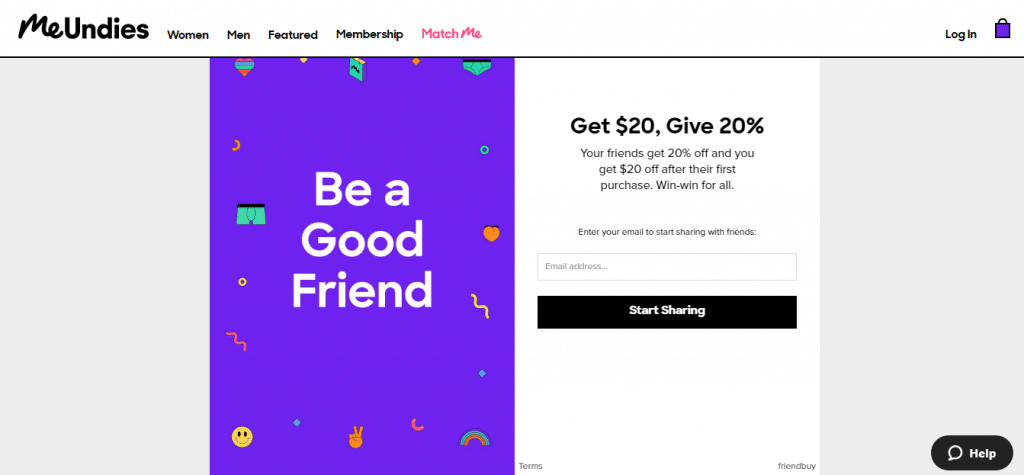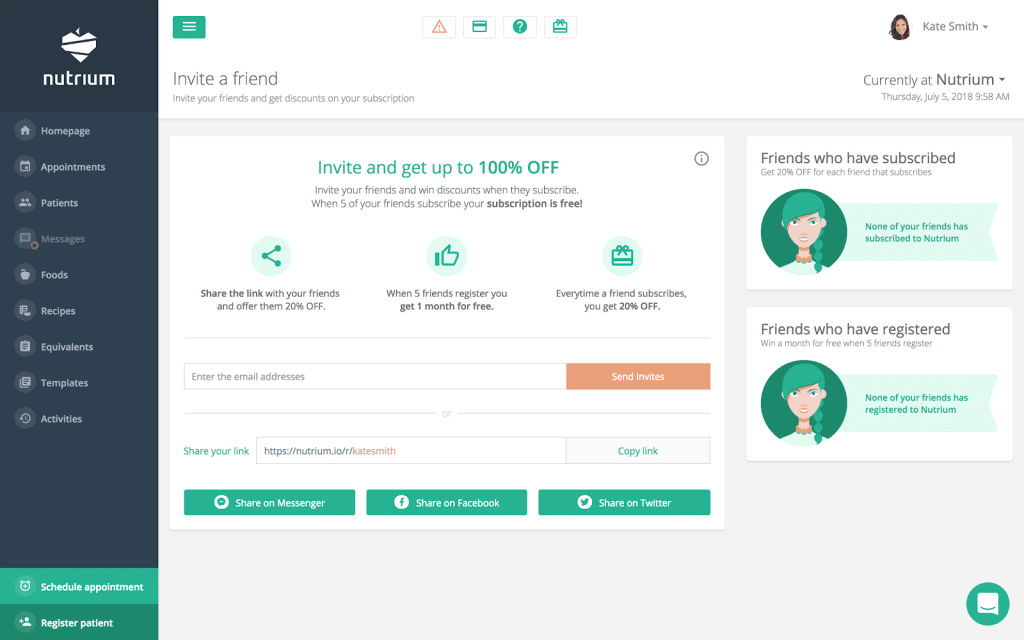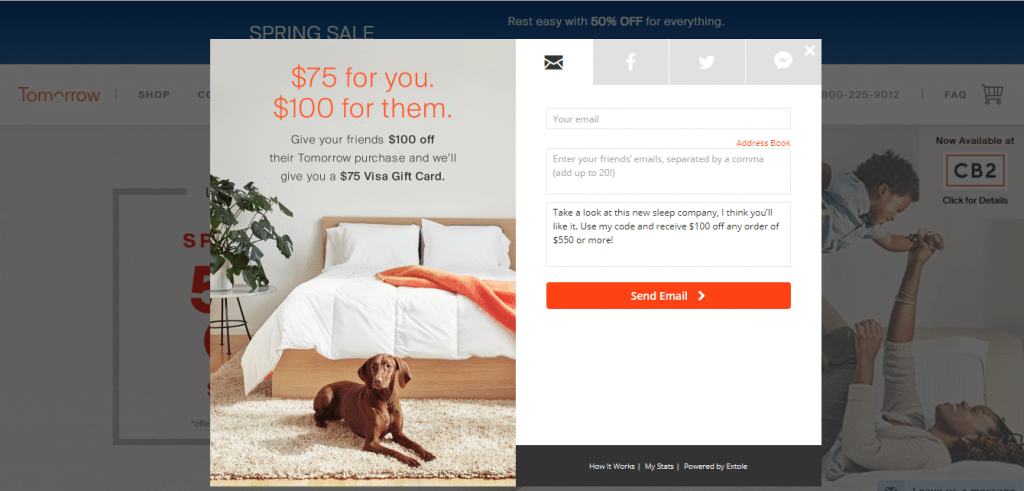A referral widget (or refer-a-friend widget) is the backbone of any successful referral marketing program, whether you’re an ecommerce brand or a B2B SaaS.
The referral widget is how customers sign up for your program and choose how they’ll share with their friends.
Today, we’ll cover what a referral widget is and why you need one. We also go over the types of referral widgets, and best practices for setting up and using one on your site.
What is a referral widget? Why do you need one?
A referral widget is the form or panel you place on your website that allows customers to sign up for your referral program and share your brand with their friends.
It also includes the HTML code used to embed the program on your website, so customers see the program in a convenient place and time.
Although people often use the term “referral widget” to mean a referral program pop-up, it can also mean any embedded referral program panel on your website that customers can use to share with friends.
An example of a referral widget on Lime Crime’s website. Source
With a referral widget, your customers can share your brand in the way that works best for them.
Referral widgets are essentially your referral marketing campaign’s backbone. They’re the sign-up point where customers can join your referral program and help grow your word of mouth.
When your customers share your brand with their friends, those friends are more likely to become your new customers – and stay loyal to your brand because they trust their peer’s recommendation.
A referral program makes it easy to promote and track this crucial word of mouth. But if your referral campaign’s widget isn’t easy for your customers to access and use, you’ll miss out on many of those warm leads.
Referral widget best practices
So, how can you maximize the placement and results of your refer-a-friend widget? We’ll cover the best practices below.
Use referral program software
It’s so much easier to create and embed a referral widget when you have referral software to guide you through the process. Referral software also helps by integrating sign-ups with your referral tracking. Don’t try to DIY a widget, as you’ll be in for a headache.
[su_icon_text color=”#474747″ icon=”icon: lightbulb-o” icon_color=”#0088cc” url=”https://referralrock.com/” target=”self”]Learn more about how Referral Rock makes it easy to create a referral widget and harness word of mouth![/su_icon_text]Make the referral widget easy to find and access
Pick the right locations on your website for the widget, and make the access points easy to find. For example, you could include a “refer a friend” link to the widget’s landing page in your top menu. Or you could create a small floating “refer a friend” widget that’s always visible and opens the full form when it’s clicked. You could also try a hero image on your homepage that directs to the widget.
Show the widget at the best times
Asking for referrals at the right time is key to referral program success. Know the key moments when your customers will be most open to engaging with the referral widget.
- Trigger the referral widget right after customers have made a purchase (as a pop-up or redirection to your refer-a-friend page after checkout).
- Include the widget when someone signs into their account on your brand website.
- If you offer credit or discounts for referrals, put a button on your homepage to entice repeat customers to refer their friends before making their next purchase.
- Send an email with a link to the widget after a customer makes a purchase (or even put the link in their receipt).
- If you offer a subscription service, include a link to the referral widget in your customer invoices, whenever their plan renews.
- Send personalized invitations or reminders to your most loyal customers – again, with direct links to your widget!
Give your customers multiple sharing options
Your customers must be able to share in a convenient way for a referral widget to work. So, offer several sharing options.
- Every referral program should give the option to share via email.
- Provide options for sharing on the social media platforms your customers use most, as this is where they naturally share information.
- Make sure to provide a unique referral link that ties back to your customer. This way, customers can copy, paste, and share the link with their friends, wherever they please.
- You can also let your customers share directly via SMS, although usually the referral link works just as well.
Make sharing easy
User experience is key, so don’t make your referral widget complicated. Use as few steps as possible for your customers to refer a friend.
- Ideally, a customer should be able just enter their email and their friend’s contact info, add a personal message if they wish, and click to share.
- Provide a unique referral link to let customers copy, paste, and share on their preferred channel.
- Simplify things even more by filling in your customer’s name and email address automatically when they’re logged into their account.
It’s best to also give a brief explanation of how the referral program works in your widget. This gives customers all the tools they need for success.
If your referral widget is easy to use, your customers will be more likely to refer more friends.
[su_icon_text color=”#474747″ icon=”icon: lightbulb-o” icon_color=”#0088cc” url=”https://referralrock.com/blog/referral-program-template/” target=”self”]Our customer referral template can help you plan an effective program that makes sharing easy and gets results.[/su_icon_text]Use an eye-catching call to action
A referral widget’s call to action (CTA) is the largest text displayed on the widget, meant to catch customers’ eyes and direct them to refer their friends to your business. It convinces customers to keep the widget open, learn more about your program, and participate.
[su_icon_text color=”#474747″ icon=”icon: lightbulb-o” icon_color=”#0088cc” url=”https://referralrock.com/blog/referral-program-call-to-action/” target=”self”]Need examples of referral calls-to-action? We’ve got you covered.[/su_icon_text]Convince customers to share with an enticing reward
Offering rewards for referring a friend, like store credits, discounts, or free products, motivates customers to take advantage of the referral widget and share with friends. In your widget, specify exactly what reward your referrers will receive for a successful referral.
Make sure the reward is promoted front and center in the widget’s referral call to action, or directly under the call to action (e.g., “Refer a friend and get 25% off!” or “$10 for you, $10 for your friend”).
Don’t be afraid to mention intrinsic rewards as well, like the opportunity to help a friend.
Promote your referral program onsite and offsite
A referral widget can’t function without solid promotion. If you’ve put all the work into your widget but your customers don’t know where to find it, it’s practically useless.
Make sure to promote your referral program via email, social media, and (as we covered before) on high-contact points on your website. Always include a direct link to the referral widget in your promotional efforts!
[su_icon_text color=”#474747″ icon=”icon: lightbulb-o” icon_color=”#0088cc” url=”https://referralrock.com/blog/how-to-promote-your-referral-program/” target=”self”]Our comprehensive guide covers everything you need to know about promoting your referral program.[/su_icon_text]Test your widget
Don’t just leave your widget be when you’ve placed it on your website. Testing and monitoring its functionality and performance enables you to learn from your design and retain what works.
A/B testing is a great option, as it lets you compare and test different copy and designs for your widget, or even different types of widgets, side by side.
Types of referral widgets
Now that we’ve gone over best practices for using refer-a-friend widgets, here’s an overview of some of the most common types.
Embedded referral program widget
This referral program widget is embedded into a designated referral program page on your website. It’s easily the most common referral widget.
User account referral widget
This embedded refer-a-friend widget is only accessible when someone is already logged into their user account on your website. If someone who isn’t logged in tries to access it, they will see a login prompt instead.
Standard pop-up widget
This referral program widget pops up on your website whenever a user completes a designated action (for example, right after they’ve made a purchase or right after they’ve logged into their user account).
Floating button widget
With this widget, users will see a button with a “refer a friend” prompt at a designated point on their screen (e.g., the right side or bottom right). They’ll see this button no matter where they scroll or click. Clicking on the button opens up a full refer-a-friend panel in a pop-up.
Go beyond the widget with robust customization
Ready to add a referral widget to your website? Learn how Referral Rock referral software can help you unlock more word of mouth, and how we go beyond the widget to help you customize a robust customer referral program!







